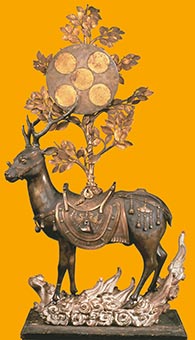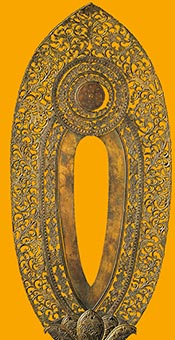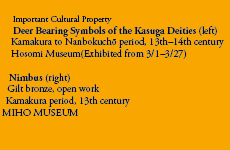
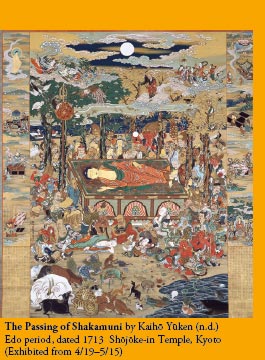
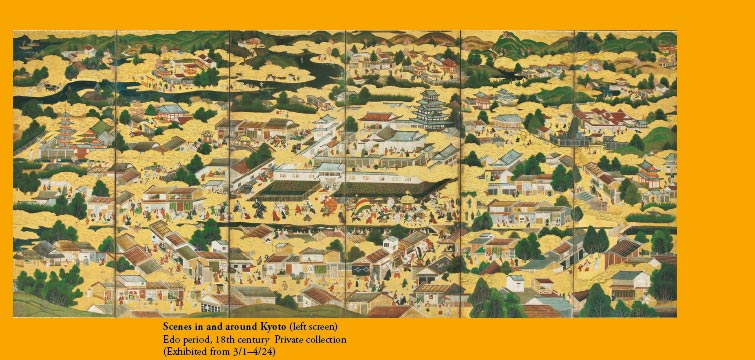
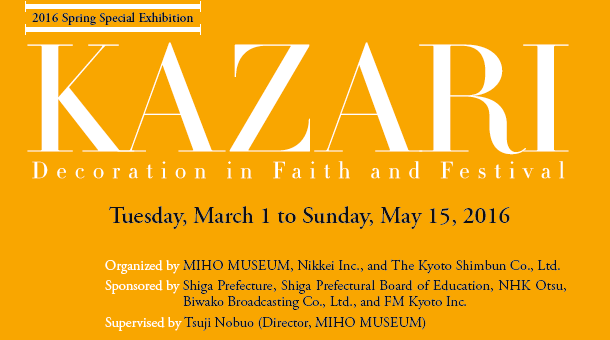
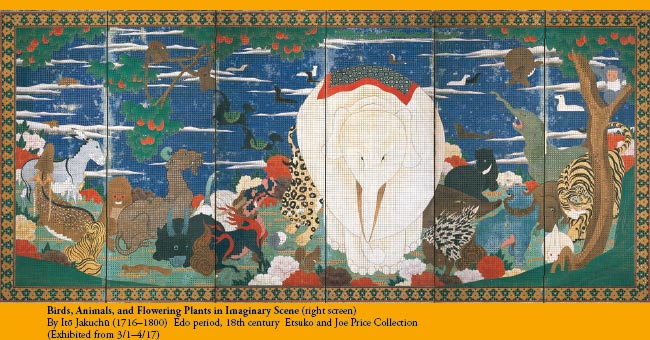

The transmission of Buddhism, together
with its profound teachings and virtue, introduced a realm of
resplendent religious decoration, or kazari, which colorfully
influenced faith in Japan.
As Buddhism expanded, it syncretized with Shinto and other indigenous beliefs and grew increasingly complex. The Japanese, who sensed Buddha nature in all things through the country’s abundant natural beauty, incorporated various animals into their belief system. In this way, through the transmission of Buddhism, people’s belief and the energy of festivals perhaps created a distinctive realm of resplendent decorativeness.
This exhibition explores the realm of kazari within the context of faith, which blossomed in Japan, through stunning Buddhist decorations, the colors and songs and dance symbolized in the ancient performances of gigaku and bugaku, the animals that appear in syncretic beliefs, and the rituals, festivals, and the festive excitement. Highlights include a mid-Edo period nehan (The Passing of Shakamuni) painting filled with animals. MIHO MUSEUM Director Tsuji Nobuo, who curated this exhibition, explains, “While nehan paintings have been produced since early times, this work is noteworthy for the myriad animals that adorn the world of the Buddhas.
This exhibition explores the realm of kazari within the context of faith, which blossomed in Japan, through stunning Buddhist decorations, the colors and songs and dance symbolized in the ancient performances of gigaku and bugaku, the animals that appear in syncretic beliefs, and the rituals, festivals, and the festive excitement. Highlights include a mid-Edo period nehan (The Passing of Shakamuni) painting filled with animals. MIHO MUSEUM Director Tsuji Nobuo, who curated this exhibition, explains, “While nehan paintings have been produced since early times, this work is noteworthy for the myriad animals that adorn the world of the Buddhas.
This realm can also be found in the artist Itō Jakuchū’s (1716–1800)
Birds, Animals, and Flowering Plants in Imaginary Scene. I find it fascinating that this earlier work predates Jakuchū.” For this reason, Dr. Tsuji created an energy corner of Itō Jakuchū’s paintings of animals and plants. Don’t miss this contest between Jakuchū’s
Birds, Animals,
and Flowering Plants in Imaginary Scene (from the Etsuko and Joe Price Collection, exhibited from 3/1 to 4/17) and his Birds and Animals in the Flower Garden (from the Shizuoka Prefectural Museum of Art, exhibited from 3/1 to 3/13).
Another feature of this exhibition includes decorations from the large floats of Shiga Prefecture’s historic festivals the Minakuchi Hikiyama Matsuri, Ōtsu Matsuri, and Nagahama Hikiyama Matsuri. The tapestries imported from China and the intricate transoms and embroideries created by popular Japanese painters and carvers demonstrate the high aesthetic sensibility of the merchants and townspeople who lived in Ōmi (modern-day Shiga Prefecture).
Another feature of this exhibition includes decorations from the large floats of Shiga Prefecture’s historic festivals the Minakuchi Hikiyama Matsuri, Ōtsu Matsuri, and Nagahama Hikiyama Matsuri. The tapestries imported from China and the intricate transoms and embroideries created by popular Japanese painters and carvers demonstrate the high aesthetic sensibility of the merchants and townspeople who lived in Ōmi (modern-day Shiga Prefecture).
The belief that adorning the Buddha produces merit crystallized in the form of Buddhist sculptures, paintings, and applied arts, and allowed devotees to channel their religious energies in front of this sublime realm. Ancient ritual music and dance, such as
gigaku and bugaku, offered during Buddhist ceremonies, and decorative processions that accompanied these festivals also emanated the “energy of festivals,” thus captivating their
spectators and spreading into an even greater fervor.
